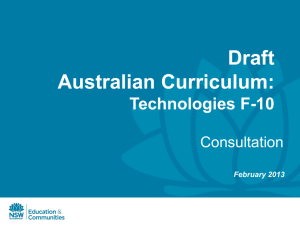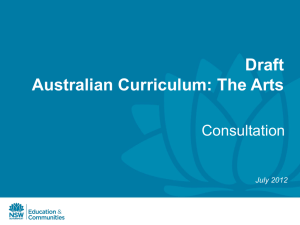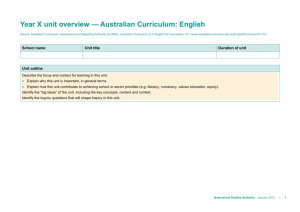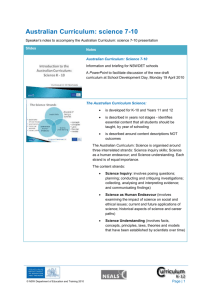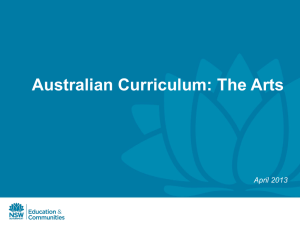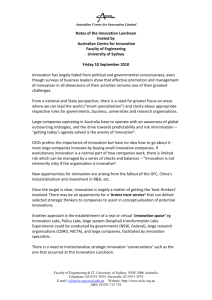Technologies Draft AC PowerPoint
advertisement
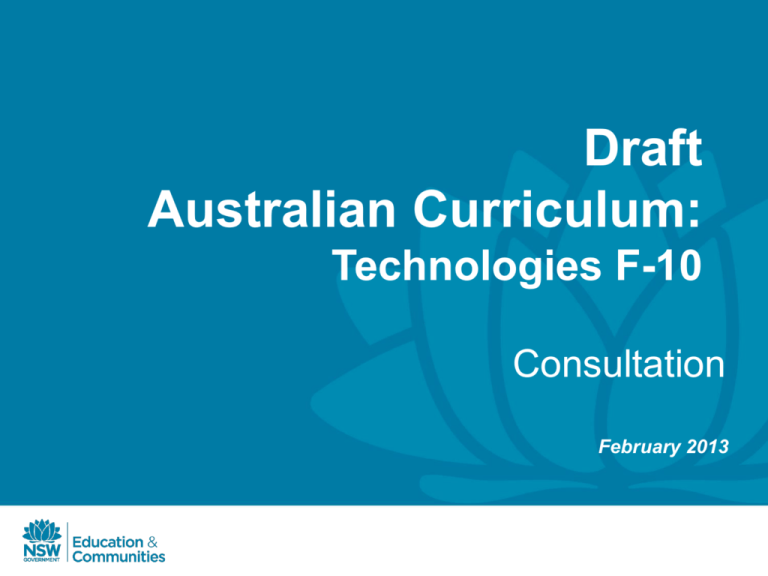
Draft Australian Curriculum: Technologies F-10 Consultation February 2013 Learning areas The Melbourne Declaration identifies Technologies as one of the essential eight learning areas Australian Curriculum development phases Phase 1 Phase 2 English Geography Mathematics Languages Science The Arts History Phase 3 Health and Physical Education Economics and Business Civics and Citizenship Australian Curriculum development Technologies consultation timeline 10 May 2013 20 February 2013 Draft Australian Curriculum: Technologies F-10 available for consultation February-April NSW Department of Education and Communities consultation on draft curriculum. - Focus groups - Video conferences - Online survey ACARA consultation closes December 2013 Curriculum publication date for the Australian Curriculum: Technologies Australian curriculum NSW syllabus development Implementation Implementation • NSW has made no commitment to implementation of the Australian Curriculum for Phase 2 and Phase 3 subjects. • The Board of Studies will follow its regular cycle of curriculum evaluation and review which will identify priorities for curriculum renewal. When a current syllabus or learning area is identified for renewal the Board will take the opportunity to incorporate Australian curriculum content. NSW BOS Memorandum To Principals July 2012 • In all cases, all schools are required to implement current approved NSW Syllabuses until otherwise advised by the Board. Organisation of the Australian Curriculum The Australian Curriculum: Technologies: • is being developed by ACARA for Foundation (K) -Year 10 • is described in band levels not Stages • has achievement standards • has content descriptions not outcomes • has content elaborations General capabilities Critical and creative thinking Ethical understanding Information and communication technology (ICT) capability Literacy Intercultural understanding Personal and social capability Numeracy Cross-curriculum priorities Aboriginal and Torres Strait Islander histories and cultures Asia and Australia’s engagement with Asia Sustainability Rationale and aims: Technologies Rationale • describes the nature of the learning area • provides an outline of learning Aims • identify the major learning that students will be able to demonstrate Organisation: Technologies The Draft Australian Curriculum: Technologies is organised into the following bands of learning: • Foundation to Year 2 • Years 3 and 4 • Years 5 and 6 • Years 7 and 8 • Years 9 and 10 Organisation: Technologies The Draft Australian Curriculum: Technologies comprises 2 subjects that all students will study Foundation-8: • Design and Technologies • Digital Technologies Rationale and aims: Technologies Technologies Rationale and Aims Design and Technologies Digital Technologies Rationale and aims Rationale and Aims • Separate Rationale and Aims for each subject • Complement and extend Technologies Rationale and Aims • More specific, describing knowledge, understanding and skills unique to Design and Technologies and Digital Technologies Content Structure: Technologies Australian Curriculum: Technologies: • 2 distinct subjects • 2 related strands Design and Technologies Digital Technologies Knowledge and understanding: Knowledge and understanding: • • • • • Technologies and society Technologies contexts Representation of data Digital systems Interactions and impact Processes and production skills: Processes and production skills: • • • • • • • Critiquing, exploring and investigating Generating, developing and evaluating ideas Planning, producing and evaluating solutions Using data Using digital systems Defining and solving problems Creating and communicating Content Structure: Technologies The common strand structure provides opportunities to: • highlight similarities across the two subjects • facilitate integrated teaching from F-8 Key ideas: Technologies Key Ideas: • Systems thinking and the overarching idea: Creating preferred futures • Project management Common to both subjects. Both strengthened from previous draft versions. Band level descriptions • Provided at the beginning of each band for each subject. • Describe the expected learning students will experience within the band. • Indicate progression of learning (knowledge, understanding and skills) from one band to the next. • Reflect the distinctive practices of each subject along with aspects of learning that are common to both Technologies subjects. Content descriptions The Draft Australian Curriculum: Technologies is structured around content descriptions for each band. Content descriptions • specify what teachers are expected to teach (mandatory) • are sequenced to develop concepts across bands Elaborations • examples that illustrate content descriptions (non-mandatory). Achievement standards • Achievement standards are provided at the end of each band of learning. • Achievement standards describe the quality of learning (depth of conceptual understanding and sophistication of their skills) indicating students are ready to commence the learning in the next band. • Achievement standards reflect the distinctive practices of each subject along with aspects of learning that are common to all Technologies subjects. Design and Technologies Organisation: Content structure Two related strands: • Design and Technologies knowledge and understanding — the use, development and impact of technologies and design ideas across a range of technologies contexts • Design and Technologies processes and production skills — the skills required to design, produce and evaluate designed solutions Organisation: Content structure Technologies contexts There are 4 Technologies prescribed contexts F – 8 : • Materials and technologies specialisations. For example: • materials, including composites, metal, plastics, wood, smart materials, textiles • an area of specialisation (for example, architecture, electronics, graphics technologies, fashion) • Food and fibre production (includes Food technologies F–4) • Engineering principles and systems • Food technologies (combines with Food & fibre production F–4). Implementing the curriculum • All design projects include all three processes and production skills • At least one product, one service and one environment design project in each band • F – 4, at least three design projects based on the three prescribed technologies contexts covered in each band • 5 – 10, at least four design projects based on the four prescribed technologies contexts in each band • multiple technologies contexts can be addressed in a single unit Scope and sequence F-10 Content descriptions and elaborations Design and technologies K – 6 An example of a Content description (mandatory) and its Elaborations (nonmandatory) from Years 5 and 6 in Design and Technologies Content description 6.5 Investigate how food preparation techniques can be selected and used to design and produce nutritious food Elaborations • • • experimenting with combining ingredients and techniques to design and produce food products examining the relationship between how food is processed, prepared and distributed and the impact on its nutrient value, for example when designing a food service system exploring food preparation techniques used in different cultures including those from the Asia region and the impact of these on nutrient retention, taste and palatability Content descriptions and elaborations Design and technologies 7 – 8 An example of a Content description (mandatory) and its Elaborations (nonmandatory) from Year 7 and 8 in Design and Technologies Content description 8.6 Incorporate principles of food processing, preparation and presentation in designing solutions for healthy eating Elaborations • considering traditional and contemporary methods of food preparation used in a variety of societies, including Aboriginal and Torres Strait Islander society and the countries of the Asia region, when designing solutions for healthy eating • understanding the need to modify ingredients in recipes to enhance health benefits • understanding the changes that occur in food during preparation, for example the browning of cut fruit, the absorption of water when cooking rice Digital Technologies Organisation: Content structure Two related strands: • Digital Technologies knowledge and understanding — information systems: data, processes, digital systems, people, and their interactions • Digital Technologies processes and production skills — defining and solving problems through using digital systems, critical and creative thinking and applying computational thinking Organisation: Content structure Key concepts • Abstraction underpins all content, particularly Representation of data; Using data and, Defining and solving problems • Data collection (properties, sources and collection of data), data representation (symbolism and separation) and data interpretation (patterns and contexts) • Specification (descriptions and techniques), algorithms (following and describing) and implementation (translating and programming) • Digital systems (hardware, software and networks) • Interactions (people and digital systems, data and processes) and impact (impacts and empowerment). Scope and sequence F-10 Digital Technologies and ICT • Clear relationship between the Digital Technologies curriculum and the ICT general capability. • The capability assists students to become effective users of ICT. • The Digital Technologies curriculum assists students to become confident developers of digital solutions. Content descriptions and elaborations Digital technologies K – 6 An example of a Content description (mandatory) and its Elaborations (nonmandatory) from Years 5 and 6 in Digital Technologies Content description 6.1 Explain how digital systems represent whole numbers as a basis for representing all types of data Elaborations • identifying that every type of data must be represented in digital systems as numbers, for example, a letter (or other character) is represented using a number and an image is represented using arrays of numbers • explaining that binary represents numbers using just 1s and 0s and these are represented as o and off electrical states in hardware • representing everyday numbers in binary, for example counting in binary from 0 to 15, using the binary system to write a friend’s birthdate in binary or using binary code to create secret messages Content descriptions and elaborations Digital technologies 7 – 10 An example of a Content description (mandatory) and its Elaborations (nonmandatory) from Year 7 and 8 in Digital Technologies Content description 8.2 Explain how data are transmitted and secured in wired, wireless and mobile networks, and understand how the specifications of hardware components impact on applications Elaborations • knowing that there are different communications protocols for specific applications, for example Hypertext Transfer Protocol (HTTP) is used for web pages, File Transfer Protocol (FTP) is used for sending and receiving files and Transmission Control Protocol/Internet Protocol (TCP/IP) is used for internet use • Learning that networks have components that control the movement of data, for example hubs, switches, bridges and routers manage date traffic Key questions for evaluating the draft F-10 Technologies curriculum Is the separation into 2 subjects appropriate F-8? Do the two related strands allow for integration of the 2 subjects? Is the language and content of Digital Technologies accessible to primary and non-specialist teachers? Does the Technologies curriculum adequately cater for student diversity? Do the content descriptions provide sufficient scope and direction? Are the prescribed contexts appropriate in Design and Technologies? What to do next… Download the Draft Australian Curriculum: Technologies Complete the NSW Department of Education and Communities online consultation survey: https://www.surveymonkey.com/s/2012technologies Additional feedback can be provided to the Board of Studies and ACARA Online consultation surveys Dept of Education and Communities Science and Technology K-6 http://www.curriculumsupport.edu cation.nsw.gov.au/primary/scitech /index.htm NSW Board of Studies http://www.board ofstudies.nsw.ed u.au/australiancurriculum// ACARA Australian Curriculum consultation http://consultation.a ustraliancurriculum. edu.au/ Your feedback is important Your feedback is important Please send any further written feedback to: • Tanya Coli tanya.coli@det.nsw.edu.au K-6 Science and Technology Advisor
